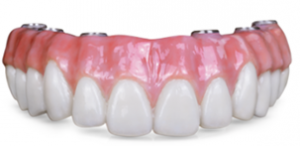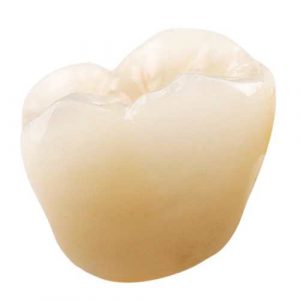Zirconia: A Dental Material Transforming Smiles
Michael Kulwiec, Editor
Dentistry is constantly evolving. One of the most significant advancements in recent years is the use of Zirconia. According to thought leaders in dentistry, Zirconia restorations are not going away. Let’s take a closer look at this revolutionary material and how to best incorporate it into your practice.
CLICK FOR PRINTER FRIENDY VERSION
What is Zirconia?
Zirconia in general is a robust and versatile material that has been adapted for use in a range of industries, from jewelry to medical applications and more recently, dentistry. Dental Zirconia, or Zirconium Dioxide, is classified as a modified yttria tetragonal polycrystalline Zirconia (Y-TZP), featuring superb mechanical properties and very good tear resistance. Thanks to its high strength, durability, and compatibility with the human body, Zirconia has emerged as a game-changer in the production of crowns, bridges, and now dental implants.
PROS AND CONS OF ZIRCONIA
Zirconia has several benefits that make it a compelling choice for dental prosthetics. Yet, despite its many benefits, Zirconia isn’t without its downsides.
Benefits
- It’s incredibly strong, with a tensile strength close to that of stainless steel, making it ideal for heavy-duty applications like full-arch implant prostheses.
- Zirconia also mimics the aesthetic appeal of natural teeth, often better than other materials, thanks to its color and translucency.
- It’s also hypoallergenic, making it a suitable choice for patients with metal allergies.
Potential Issues
- The material’s rough surface can lead to wear on opposing teeth if not polished correctly.
- Can sometimes be slightly opaque compared to natural teeth, which may require careful color matching for the best aesthetic results.
These potential issues highlight the importance of partnering with a trusted dental lab, like Dental Masters, that has the experience and expertise to create high-quality Zirconia restorations.
PFM & Lithium Disilicate VS Zirconia
Porcelain-fused-to-metal restorations (PFMs) have been used for decades with a proven track record of reliability and performance. They provide a strong and durable solution, and with an adequately thick porcelain layer, deliver an aesthetically pleasing appearance. However, they do have drawbacks, such as the potential for gum-line discoloration over time and the risk of porcelain chipping off.
Lithium Disilicate materials such as Ivoclar’s eMax offer proven superb esthetics and reliability. However, these benefits must be weighed against the need for greater tooth reduction, required shoulder margins, and lower fracture resistance (500 MPA).
Over the last five years we have witnessed the emergence of a new generation of Zirconia, known as Monolithic, Multi-Layered Zirconia. These new generation Zirconias successfully address limitations associated with PFM and Lithium Disilicate restorations. Monolithic Multi-Layered Zirconia restorations (when compared to prior-generation single-layer dental Zirconia) have greater vitality, more translucency and offer a combination of strength and aesthetics that rival PFM restorations along with well-known Lithium Disilicate materials.
A systematic review published in the Journal of Prosthodontic Research in 2017 found that Zirconia-based restorations could have similar, if not better, survival rates compared to PFM restorations, depending on the location in the mouth and the length of the span if it’s a bridge.
KEY TAKEAWAY ON PFM & LITHIUM DISILICATE VS ZIRCONIA
While PFM and Lithium Disilicate restorations are still used and can be the right choice in specific cases, more recent improvements made to Zirconia dental materials (i.e., multi-layer monolithic) provide an alternative that may better meet the needs of many patients. Zirconia can offer a highly aesthetic, strong, durable solution, without the aesthetic drawbacks associated with PFMs and without the strength limitations and prep requirement of Lithium Disilicates.
Zirconia Options at Dental Masters
Dental Masters offers a variety of Zirconia-based solutions tailored to meet the diverse needs of clients and patients.
ZirTek® zirconia offers a strong solution for all restorative needs and is available exclusively from Dental Masters Laboratory. ZirTek® restorations feature both durability and esthetics.
ZirTek® crown restorations have a lab turnaround time of 3 to 5 days and come with a Lifetime warranty.

ZirTek® Solid Zirconia Full-Arch Implant Prosthesis: Designed for its unparalleled strength and durability, this full-arch implant solution withstands heavy occlusal forces with patient-pleasing esthetics. (Includes final prosthesis, labor, model and die work, analogs, setup, bite blocks, try-ins and verification jigs.)

ZirTek® Esthetic: ZirTek® Esthetic is an esthetic zirconia material for the anterior and posterior region. (Posterior single unit use is indicated, provided there is sufficient full contour reduction.) Bridges are indicated up to 3 units in the anterior and posterior. Featuring average flexural strength of 850 Mpa, ZirTek® Esthetic is a multi-layered zirconia with internal color gradation and fluorescence, yielding highly esthetic and natural-appearing restorations.

Zirtek ® Full-Strength: ZirTek® Full-Strength is a multi-layered, posterior restorative zirconia option designed to match the VITA® Classical Shade Guide, which offers precise fit, form, and function. ZirTek® Full-Strength features internal multiple shade layers which create a natural shade gradation, from cervical to occlusal. With an average flexural strength of 1200 MPa, this restoration is ideal for single crowns and bridges of three to four units.
What Does the Research Say about Zirconia?
Multiple scientific studies and clinical trials have demonstrated the efficacy of Zirconia in dental applications.
A review in the Journal of Prosthodontic Research in 2019 found that Zirconia-based restorations had satisfactory clinical performance and were a viable alternative to metal-ceramic restorations.(2)
Moreover, a comprehensive review in the Journal of Dental Research in 2017 found that Zirconia-based dental restorations had comparable or even superior mechanical properties compared to their metal-based counterparts, highlighting their suitability for long-term oral rehabilitation.(3)
While Zirconia is now a proven material, it is not without its challenges. For example, researchers have noted the importance of proper manufacturing, finishing, and maintenance of Zirconia restorations to minimize wear on opposing teeth.(4)
At Dental Masters, our goal is to provide Zirconia-based dental prosthetics that cater to diverse patient needs and requirements. By leveraging cutting-edge technology and superior craftsmanship, we ensure each patient gets the most out of this revolutionary dental material.
Your next issue of Dental Insight
The next issue of Dental Insight will review current chairside techniques and materials for the proper adjustment and polishing of Zirconia restorations upon placement. These insights will aid in your Zirconia material selection, improve communications with your laboratory and help ensure successful, long-term Zirconia restorations.
At Dental Masters, our goal is to provide Zirconia, Lithium Disilicate & PFM dental prosthetics that meet diverse patient requirements. By leveraging cutting-edge technology and superior craftsmanship, we ensure each patient gets the most out of current, proven dental materials.
CONTACT US
CALL US: 800.368.8482
PRINTER FRIENDLY VERSION
References
1.Pjetursson, B.E., Sailer, I., Makarov, N.A., Zwahlen, M., Thoma, D.S. (2017). All-ceramic or metal-ceramic tooth-supported fixed dental prostheses (FDPs)? A systematic review of the survival and complication rates. Journal of Prosthodontic Research
2. Harada, K., Raigrodski, A. J. (2019). Longevity and Failure Load of Ceramic Veneers with Different Preparation Designs: An In Vitro Study. Journal of Prosthodontic Research.
3. Zhang, Y., Kelly, J. R. (2017). Dental Ceramics for Restoration and Metal Veneering. Dental Clinics.
4. Sailer, I., Makarov, N. A., Thoma, D. S., Zwahlen, M., Pjetursson, B. E. (2015). All-ceramic or metal-ceramic tooth-supported fixed dental prostheses (FDPs)? A systematic review of the survival and complication rates. Part I: Single crowns (SCs). Dental Materials.

